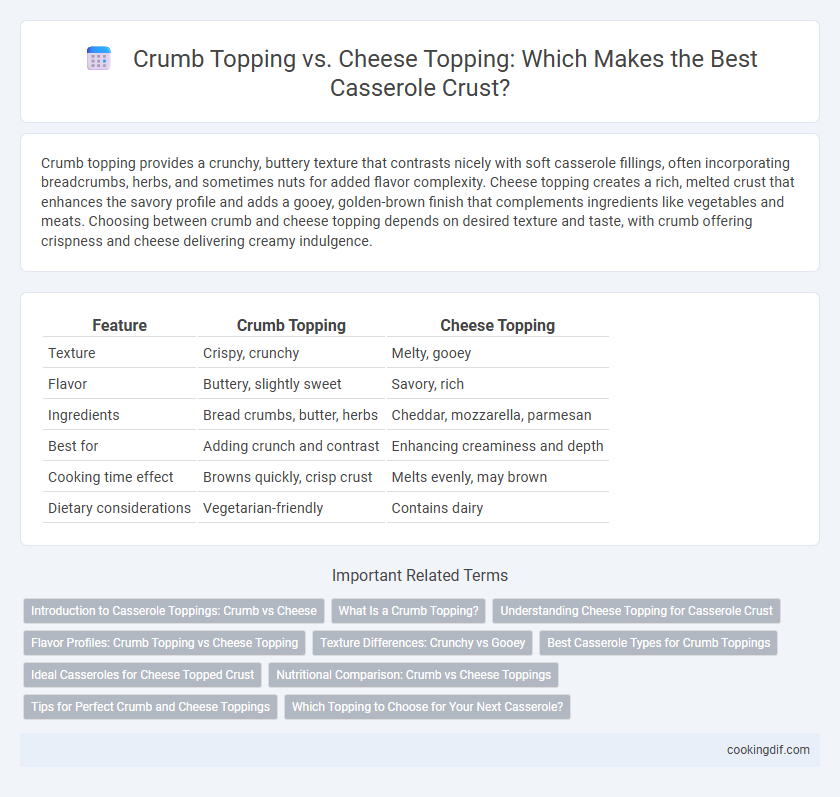Crumb topping provides a crunchy, buttery texture that contrasts nicely with soft casserole fillings, often incorporating breadcrumbs, herbs, and sometimes nuts for added flavor complexity. Cheese topping creates a rich, melted crust that enhances the savory profile and adds a gooey, golden-brown finish that complements ingredients like vegetables and meats. Choosing between crumb and cheese topping depends on desired texture and taste, with crumb offering crispness and cheese delivering creamy indulgence.
Table of Comparison
| Feature | Crumb Topping | Cheese Topping |
|---|---|---|
| Texture | Crispy, crunchy | Melty, gooey |
| Flavor | Buttery, slightly sweet | Savory, rich |
| Ingredients | Bread crumbs, butter, herbs | Cheddar, mozzarella, parmesan |
| Best for | Adding crunch and contrast | Enhancing creaminess and depth |
| Cooking time effect | Browns quickly, crisp crust | Melts evenly, may brown |
| Dietary considerations | Vegetarian-friendly | Contains dairy |
Introduction to Casserole Toppings: Crumb vs Cheese
Casserole toppings enhance texture and flavor, with crumb and cheese toppings offering distinct benefits. Crumb toppings typically consist of breadcrumbs mixed with butter and herbs, creating a crunchy, golden crust that contrasts with creamy casserole fillings. Cheese toppings, made from varieties like cheddar or mozzarella, melt into a gooey, savory layer that adds richness and depth, appealing to those seeking a decadent finish.
What Is a Crumb Topping?
A crumb topping for casseroles consists of a mixture of breadcrumbs, butter, and seasonings, creating a crunchy, golden crust that enhances texture and flavor. Unlike cheese toppings that add a rich, creamy layer, crumb toppings deliver a lighter, crispy contrast to the casserole's filling. This topping is especially popular for dishes like macaroni and cheese, vegetable bakes, and chicken casseroles where a crunchy finish is desired.
Understanding Cheese Topping for Casserole Crust
Cheese topping for casserole crust enhances flavor and adds a rich, creamy texture that melts beautifully during baking. Varieties like cheddar, mozzarella, or parmesan create a savory, golden-brown crust that complements diverse casserole ingredients. Cheese toppings also provide a protein boost and a satisfying, crispy finish that distinguishes casseroles from those with traditional crumb toppings.
Flavor Profiles: Crumb Topping vs Cheese Topping
Crumb topping for casseroles delivers a crunchy texture with a buttery, slightly sweet flavor that complements savory ingredients without overpowering them. Cheese topping creates a rich, creamy crust with a salty, umami depth that enhances the casserole's overall taste. Choosing between crumb and cheese toppings depends on whether a subtle contrast or a bold, savory finish is desired for the dish.
Texture Differences: Crunchy vs Gooey
Crumb topping on casserole crust provides a crunchy texture that contrasts with the soft casserole filling, offering a satisfying bite and a golden, crisp surface. Cheese topping creates a gooey, melty layer that adds richness and a creamy, stretchy texture, often browning nicely to enhance flavor. Choosing between crumb and cheese topping depends on the desired texture experience--crispy crunch versus smooth, gooey indulgence.
Best Casserole Types for Crumb Toppings
Crumb toppings, made from ingredients like breadcrumbs, oats, and nuts, provide a crunchy texture and are best suited for casseroles such as green bean casserole, chicken and rice casserole, and tuna noodle casserole. These toppings absorb moisture while adding a golden, crispy crust that complements creamy or saucy bases. Unlike cheese toppings, crumb crusts avoid excessive greasiness and balance the flavors in vegetable or poultry casseroles, enhancing both taste and presentation.
Ideal Casseroles for Cheese Topped Crust
Cheese toppings create a rich, golden crust perfect for casseroles like macaroni and cheese, broccoli, cheddar bake, and chicken Alfredo. The melted cheese adds a savory depth and crispy texture that complements creamy or cheesy fillings. Dishes with robust flavors and creamy sauces benefit most from the savory crunch of a cheese crust over crumb toppings.
Nutritional Comparison: Crumb vs Cheese Toppings
Crumb toppings for casseroles typically contain breadcrumbs, butter, and sometimes herbs, providing a moderate calorie count and offering fiber from whole grain crumbs, while cheese toppings add higher protein and calcium content but also increase saturated fat and sodium levels. Nutritionally, crumb toppings are generally lower in fat and calories, making them a lighter option for those monitoring weight or cholesterol. Cheese toppings contribute essential nutrients like calcium and vitamin B12 but can raise the dish's overall fat and calorie density, impacting heart health if consumed in excess.
Tips for Perfect Crumb and Cheese Toppings
For a perfect crumb topping on casseroles, use a blend of panko breadcrumbs, melted butter, and a sprinkle of herbs to achieve a crunchy, golden crust. Cheese toppings work best with sharp varieties like cheddar or Parmesan, which melt evenly and create a rich, flavorful layer. Ensure even distribution of topping ingredients and bake uncovered at moderate heat to allow the crust to crisp without burning.
Which Topping to Choose for Your Next Casserole?
Crumb topping offers a crunchy, buttery texture that pairs well with vegetable or chicken casseroles, enhancing flavor with a subtle, nutty finish. Cheese topping provides a rich, gooey layer that melts into the casserole, ideal for hearty dishes like beef or pasta casseroles, adding depth and savory appeal. Choose crumb topping for lighter, crisp contrast and cheese topping for creamy, indulgent richness to elevate your next casserole dish.
Crumb topping vs Cheese topping for casserole crust Infographic

 cookingdif.com
cookingdif.com